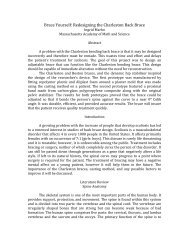A Study of Tensile Degradation of Bioresorbable Materials Used for ...
A Study of Tensile Degradation of Bioresorbable Materials Used for ...
A Study of Tensile Degradation of Bioresorbable Materials Used for ...
You also want an ePaper? Increase the reach of your titles
YUMPU automatically turns print PDFs into web optimized ePapers that Google loves.
<strong>Degradation</strong> <strong>of</strong> <strong>Bioresorbable</strong> <strong>Tensile</strong> Bars<br />
suffer higher stress in median and paramedian fractures then in column or angle fractures. A<br />
prediction was made that insisted contact between the mandible and the fixation plate is<br />
necessary <strong>for</strong> successful function <strong>of</strong> the surgery. Results <strong>of</strong> the experiment using bioresorbable<br />
plates showed that the biomaterials can be used in certain circumstances <strong>of</strong> mandibular fractures.<br />
Median and paramedian fractures are best treated using two fixation plates, while angle fractures<br />
should be treated with one if contact with the lower portion <strong>of</strong> the bone is certain. One plate must<br />
also be used in a column fracture, and the plates must be approximately 2.0 or 2.5 mm in<br />
thickness. <strong>Bioresorbable</strong> fixation plates can be used in mandibular fractures in circumstances<br />
where a perfect alignment <strong>of</strong> repositioning is a guaranteed result. However, these plates are not<br />
successful when used in a mandibular column fracture (Krach et al., 2008, p. 67).<br />
PLA/PGA Plates and Screws <strong>for</strong> Internal Fixation <strong>of</strong> Mandibular Fractures<br />
Progress in the areas <strong>of</strong> biomaterials testing has produced a surge in using the<br />
biomaterials as fixation devices in fractures <strong>of</strong> the mandible. This study by Ferretti tested<br />
PLA/PGA compounds as plates and screws in the fixation <strong>of</strong> mandibular fractures in 31 patients.<br />
Follow up visits <strong>for</strong> patients occurred at 1 week, 6 weeks, and 3, 6, and 12 months post surgery.<br />
Pain and swelling were some <strong>of</strong> the symptoms <strong>for</strong> which patients were checked. Twenty-nine<br />
patients completed the trial with complete union <strong>of</strong> the bone fracture. Two participants in the<br />
trial were withdrawn when they were unwilling to return <strong>for</strong> a follow up or had been assaulted<br />
(Ferretti, 2008, p. 242). General anesthesia and amoxicillin were used during the surgery. The<br />
PLA/PGA compound used in this trial was 82% lactide and 18% glycolide. After the operation,<br />
patients stayed on oral amoxicillin <strong>for</strong> 5 days, and a particular mouthwash was used to keep the<br />
site <strong>of</strong> surgery disinfected. Furthermore, all patients were kept on a liquid diet <strong>for</strong> 6 weeks<br />
(Ferretti, 2008, p. 243). The results <strong>of</strong> this study show that PLA/PGA fixation has a 22.5%<br />
complication rate. Twenty patients completed the trial with no complications subsequent to the<br />
surgery. Complications were present in 9 patients, but no patients suffered a non-union <strong>of</strong> the<br />
fracture. Because the complication rate <strong>of</strong> using titanium fixation ranges from 13.7% to 43%,<br />
PLA/PGA polymer plate and screw fixation <strong>of</strong> mandibular fractures is an excellent alternative<br />
(Ferretti, 2008, p. 242).<br />
Biodegradable Fixation <strong>of</strong> Mandibular Fractures in Children<br />
Recently researchers have expressed an interest in bioresorbable fixation in children. One<br />
study at the Medical University <strong>of</strong> Vienna aimed to discover the safety and stability <strong>of</strong> short term<br />
results <strong>of</strong> biodegradable fixation in fractures <strong>of</strong> children’s mandibles. Thirteen children, ages<br />
ranging from 5 to 16 years, participated in this trial. They were all operated on <strong>for</strong> various<br />
fractures <strong>of</strong> the mandible and attended follow-up visits <strong>for</strong> approximately 2 years after the<br />
surgery was per<strong>for</strong>med (Yerit, Hainich, Enislidis, Turhani, & Klug, 2005, p. 1). All patients<br />
experienced full union <strong>of</strong> the mandibular fracture. None <strong>of</strong> the participants suffered from<br />
undesirable reactions to the biodegradable materials. All complications experienced were minor<br />
and none <strong>for</strong>ced removal <strong>of</strong> the biodegradable plates. The results depict that pediatric patients<br />
take well to biodegradable fixation <strong>of</strong> mandibular fractures. Children can benefit from<br />
biomaterials because mobility is achieved faster than if titanium is used. Also, the patients will<br />
not need to undergo a second removal surgery that is especially uninvited in pediatric patients.<br />
These results depict that biodegradable fixation is safe and superior to titanium in pediatric<br />
patients. Further studies will be necessary to establish the long term effects and reliability <strong>of</strong><br />
biomaterials used in children (Yerit et al., 2005, p. 1).<br />
9
















